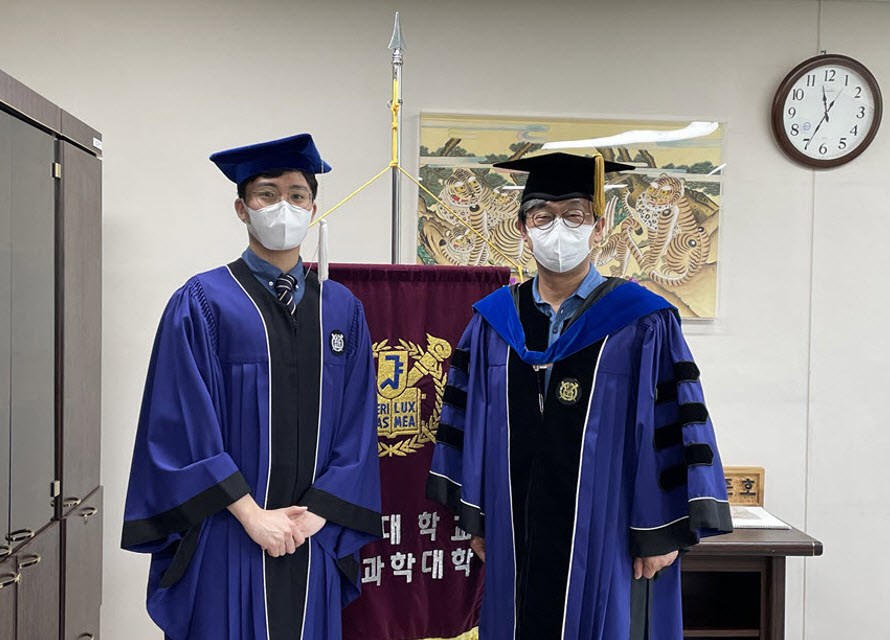After just seven semesters, Seo Junseok received his bachelor’s degree from the Department of Physics and headed to the Massachusetts Institute of Technology (MIT) this fall to pursue a PhD. He considers himself lucky. I consider myself lucky too, but I didn’t graduate as valedictorian with a GPA of 4.29/4.30 like Seo Junseok did. Add to that the two papers he published as an undergraduate, and it’s no wonder friends and peers call him “the Korean Einstein.”

Seo Junseok (left) and Dean of College of Natural Sciences Junho Lee
As an undergraduate, you’ve studied condensed matter physics and have published two papers on 2D semiconductors. Why?
When I was a student at Daegu Science High School, I took part in a research and education program that allowed me to meet Professor Lee Takhee (SNU Department of Physics). I returned to Professor Lee’s office as an SNU student in my second year and started learning about molecular nanoelectronics and condensed matter physics. At first, I was interested more in theoretical physics, but Professor Lee steered me towards applied physics. I liked that even an undergraduate like me was welcome in the lab and I liked how I could talk to Professor Lee freely about physics.
In your third year at SNU, your research on field-effect transistors was selected as the Best Undergraduate Research Project of 2018, and was later published in 2019 in Nanoscale Research Letters. Could you tell us more about your work?
That was my first project after I joined Professor Lee’s lab. I tried to learn more about the changes that took place during thermal annealing of field-effect transistors in ambient conditions. 2D semiconductors have slow photoreaction rates but we found that we can speed this up using a relatively facile doping method. The most difficult aspects of my first project were finding what interested me and learning how to write an academic paper. This was an important first step into academia, and through this opportunity, I was able to do better in subsequent projects.
Your second project was about the development of ultrasensitive photodetection in avalanche phototransistors. Could you tell us more about this as well?
The avalanche breakdown phenomenon involves the sudden generation of very large currents by free-flowing outer electrons that increase in velocity and incite the rapid breakdown of interior electrons. This phenomenon was utilized in silicon and other 3D high-sensitivity optical sensors but we felt that its application in 2D semiconductors could dramatically increase sensitivity. I’d almost finished my research by 2019 but had to put it aside for a while because of military service.
Why did you decide to pursue your PhD at MIT, and what are you excited about learning?
I had to think a lot about what I really wanted to do. I had fun learning about transistors, photosensors, and other aspects of applied physics, but I was equally excited about theoretical physics. In the end, I decided to spend the next six or so years on learning theoretical physics. In 2018, Professor Pablo Jarillo Herrero from MIT showed that slightly altering the angle of two 2D graphene lattices induced superconductor behavior. A lot of other interesting discoveries are constantly being made in his lab and I’d like to explore some of these phenomena from an optical perspective.
Why do you believe theoretical physics will be important in the future? What do you love about physics?
I think that discoveries or breakthroughs in theoretical physics set the foundation for revolutions in engineering that better our lives. Compared to supercomputers, which require huge amounts of energy to predict something like the weather, the human brain is capable of creative thought with just a spark. This shows that nature is in many ways unbeatable, and it shows the advantages of mimicking nature, a principle that has given rise to biomimetic fields such as neuromorphic engineering. For fields like neuromorphic engineering to exist, we need a robust understanding of physics.
To me, physics is all about learning the secrets of the universe, and the joys of discovery are second to none. Mankind has learned so much more about nature since the revolution started by Newton less than 500 years ago, in part due to the revelations that have come from the field physics. I believe that physics is the foundation of modern times. There are times when studying physics is almost overwhelming in its sublimity, but this very sublimity is my inspiration to continue learning.
Source: https://www.snu.ac.kr/snunow/snu_story?md=v&bbsidx=133041
Written by Cheesue Kim, SNU English Editor, cheesuerocket@gmail.com
Reviewed by Professor Travis Smith, Department of Asian Languages and Civilizations, tlsmith@snu.ac.kr

